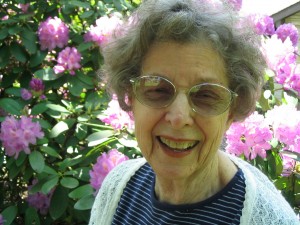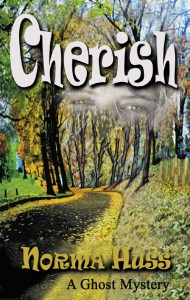 Relevant History welcomes Norma Huss, who calls herself “The Grandma Moses of Mystery.” She’s a wife, mother, grandmother, (soon to be great-grandmother), and author. Her mysteries for adult readers are set along Chesapeake Bay, where she and her husband sailed for many years. Her non-fiction is a telling of her father’s youthful adventures in Alaska. YA fiction Cherish is a blend of generations, and needed a lot of input from the younger generation to ever appear. It’s a Halloween book that grandma and grandchild can enjoy together—each will learn something about the other’s teen life and “social media.” For more information, check her web site and blog.
Relevant History welcomes Norma Huss, who calls herself “The Grandma Moses of Mystery.” She’s a wife, mother, grandmother, (soon to be great-grandmother), and author. Her mysteries for adult readers are set along Chesapeake Bay, where she and her husband sailed for many years. Her non-fiction is a telling of her father’s youthful adventures in Alaska. YA fiction Cherish is a blend of generations, and needed a lot of input from the younger generation to ever appear. It’s a Halloween book that grandma and grandchild can enjoy together—each will learn something about the other’s teen life and “social media.” For more information, check her web site and blog.
*****
A young teen’s view of World War II
I had just turned twelve a month before that Sunday afternoon when we heard the news. My family sat in the living room around the wood stove, listening to the radio while my mother and I cleaned eggs with sandpaper brushes before they would be sold to city folks. My father relaxed before milking cows. My younger brother and sister played. The Japanese had bombed Pearl Harbor in Hawaii.
Over the days ahead, we heard our president tell us we were at war. Since I lived close to the west coast, we feared the Japanese. (My husband, as a child in Pennsylvania, feared the Germans.) We had air raid drills at school, we covered our windows so light wouldn’t seep out, we bought savings stamps. My father took a first aid course and learned how to stop bleeding. My mother spotted planes.
One day at school, mimeographed sheets were given to the oldest child in the family. After the parents read the sheet, it had to be returned the next day. We were to watch and report any sighting of incendiary bombs. The Japanese were floating balloons carrying them across the ocean. The government didn’t want Japan to know a few had landed.
In a few months we received our ration books with stamps of different colors, one for every member of the household. On a Sunday, we heard over the radio what each color stood for. Red stamps were for meat and butter. Another color was for canned vegetables. Sugar was rationed, as were shoes and gasoline. Since we lived in the country, we grew much of our own food, including meat, so we used our meat coupons for butter. Since each person had the same ration of shoes, families with small children found it more difficult to manage keeping those growing feet shod. Gasoline rations were separate. Farmers received more than enough to run their tractors to keep food production up. The speed limit was reduced to 35 miles an hour, saving on fuel, but also reducing accidents caused by worn out tires. (Rubber for tires was in very short supply.)
Some of the products we see in our stores today began life as non-rationed goods to replace rationed items. Play shoes made without leather or rubber were soon available. They became quite popular, and, in some cases, necessary. Cake mixes, on the other hand, were a failure. They tasted awful. My mother was disgruntled that some companies were getting allotments of sugar to mix up something so useless. (The did improve with time, until, today, they are probably more popular than home made cakes.) Production of fake butter, called oleomargarine flourished.
Internment of Japanese residents
When the war began, we lived in an area largely populated by German immigrants. This was not a problem with us. The kids were our classmates and friends. Others accepted Italians as well. The people who lived with Japanese neighbors weren’t so benevolent. My aunt, who taught school near Seattle, told us a story, which may have been an urban legend before its time. She said a teacher asked a child what they would do if the government took the father away to a camp. The child supposedly replied, “Then my mother will light the candle on the roof.”
In any event, the Japanese families, over half of them American citizens, were moved completely out of California and the western half of both Washington and Oregon. (Less than 2,000 of the over 150,000 Japanese Americans in Hawaii were interned.) I later worked with two of the Japanese women who had been interned. One had been a child. She told me they asked the man of the family two questions. “Do you swear allegiance to the United States?” and “Will you fight against Japan?” Those who replied “No,” to both questions were kept in internment until the war was over, then sent to Japan. Those who replied, “Yes,” to both questions were released, but could not return to their own homes until after the war.
Of the two women I knew, the older one had been released with her family. During the war she worked for the government in Washington D.C. After the war, when her family returned to the Seattle area, they discovered the farm they had signed over to friends to “save”, had been sold by the supposed friends who left with the money.
The other woman’s father had been born in the United States of immigrant parents. He went to Japan to choose a wife and returned to farm in America where the children were born. He said, “Yes,” he was a loyal American, but “No,” he wouldn’t fight against his wife’s family in Japan. They stayed in the internment camp until the war was over, then returned to the Seattle area. The absolute worst, my friend said, was dealing with all the others in the camp who had said, “No, No.” They tried to turn her family against America.
The book, Cherish
My book for teens is Cherish (A Ghost Mystery). It’s a story that spans the centuries with today’s Kayla, and Cherish, a teenage ghost from 1946. Cherish, fifteen in 1946, would have lived through World War II, just as I did. But, just as I did, by 1946, a year after the war was over, she didn’t dwell on it. Others did.
*****
 A big thanks to Norma Huss. She’ll give away a paperback copy of Cherish to someone who contributes a comment on my blog this week. I’ll choose the winner from among those who comment by Saturday at 6 p.m. ET. Delivery is available within the United States only.
A big thanks to Norma Huss. She’ll give away a paperback copy of Cherish to someone who contributes a comment on my blog this week. I’ll choose the winner from among those who comment by Saturday at 6 p.m. ET. Delivery is available within the United States only.
**********
Did you like what you read? Learn about downloads, discounts, and special offers from Relevant History authors and Suzanne Adair. Subscribe to Suzanne’s free newsletter.

Thanks for inviting me to visit your blog, Suzanne.
You’re welcome, Norma!
My parents were a bit older than Norma, both born in 1924. My Dad had joined the Navy in July of 1941, straight out of high school, and was aboard his aircraft carrier (USS Ranger), one day’s sailing from the Hampton Roads on December 7,1941.
I remember my mother telling me about the shoe rationing. She told me that one year her grandmother gave her her own shoe ration stamps for Christmas. Her grandmother told her that she had plenty of shoes already and that a young woman would need new shoes more.
The questions put to Japanese-Americans, especially the one “Will you fight against Japan” turned out to be a rather pointless one, as no Japanese-Americans who enlisted were sent to the Pacific Theater. All were sent to Europe and fought in segregated units, most notably the 442nd Infantry, which fought with distinction in Italy.
Tracy, I also knew that no Japanese Americans were sent to the Pacific.
One part of my book is someone’s paranoia over a returning G.I. with a German name. I don’t know if that sort of thing really happened, but I do know the son of one of our German neighbors was perpetually a few steps ahead of the F.B.I.—or some government group—because of his anti-American actions.
Yes, there was the German-American Bund, comprised of Nazi sympathizers.
Ah, I learned something. All I knew at the time was that some government men came looking for the son who had stopped to see his parents for one day. He was long gone by then, and even the neighbors hadn’t known he’d been there.
I was born after the war, but I remember my mother, grandmother and mother-in-law talking about oleo, Victory Gardens, and what life was like. Very interesting post, Norma! Thank you for sharing.
Marja, did they mention the little yellow tube in the white bag of oleo to color it? In Seattle, even in the mid-1950s, when I was working, they couldn’t sell colored oleo. It was white as lard, and one massaged the bag to distribute the color for yellow oleo.
Ick!
A fascinating essay,Norma! And such a sorrowful, poignant time for Japanese-Americans. I was too young to remember much about WW2, but the last year of the war my much-older brother flew B-29s over the Indian “Hump” (so called) en route to bomb Japan, and was shot down over China. His plane crashed in a rice paddy and barely missed a Chinese tea house. He bailed out in time, but was injured when he landed. My mother fainted when she received a telegram staying he’d been “wounded in action”–when he just had a broken ankle.
Nancy, that must have been scary with a brother in the war. My uncle was the only relative I knew in the war. He was a mechanic at an air field in England. He said they had a fake air field a few miles away that was bombed repeatedly. Every time they’d go there and smooth out the holes and set up the airplane bodies for the next bombing run. However, my husband’s uncle was killed in Italy.